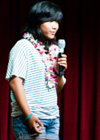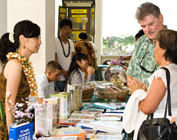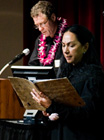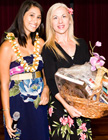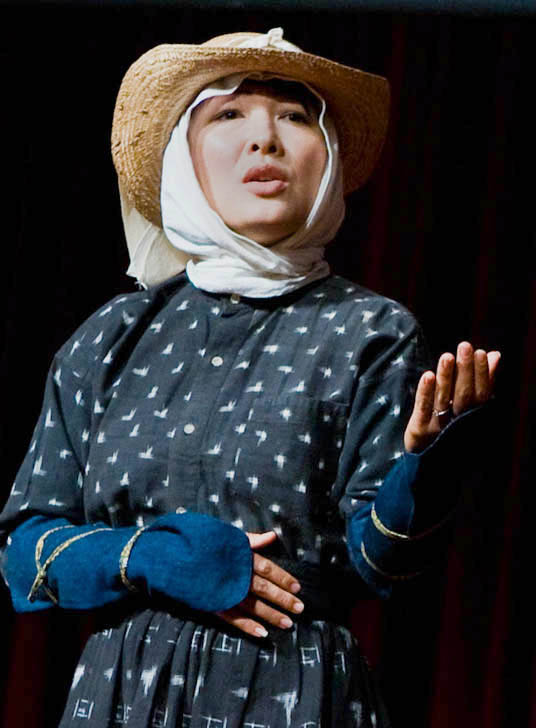2010 Program
Hawai‘i Convention Center's Theater 310
at the Jean Charlot Courtyard, Honolulu, Hawai‘i
Saturday, October 23, 2010
Morning Presentations
Living Museum displays in the Jean Charlot Courtyard
Kapa Display - with Ka‘iulani de Silva renowned kapa practitioner
Barkcloth-a light, strong cloth called kapa in Hawai‘i and tapa in the rest of Polynesia-dominated Hawaiian textiles until contact with Europeans. Hawaiian kapa designs were among the most innovative of the Pacific Islands. The display provides an introduction to this ancient Hawaiian art form thru kapa samples, tools, plants, and informal discussion.
Display Sponsor: Kalihi-Pālama Culture and Arts Society
Early Hawaiian Literacy Display
Following the Protestant missionaries 1820 arrival from New England, work began with native Hawaiians to develop a written Hawaiian alphabet for translating the Bible. The missionaries were highly educated and shared this education with the people of Hawai‘i. The end result was that the Kingdom of Hawai‘i was one of the most literate nations of its time. The display shares the methods used to teach reading and writing to the Hawaiian people which allowed them to create a written record of their history.
Display Sponsor: Mission Houses Museum
Administrative Announcements, Emcee Raine Arndt
Welcome by Michael Munekiyo, Hawai‘i Council for the Humanities
Opening Chant by Jonah La‘akapu Lenchanko of Hālau O Kawailani and 34th King Kamehameha Hula Competition-1st in Chant Division, chant selection O Ua Ao Noweo
Hawaiian Letter Writing Woman: Queen Emma [1836-1885]
Readings of selected political and personal letters between Queen Emma and her cousin, from News from Molokai, Letters between Peter Kaeo & Queen Emma, 1873-1876. The letters also explored in the context of the history of Kalaupapa, Moloka‘i and late 19th century letter writing.
Presenters: Craig Howes, Ph.D., Director, Center for Biographical Research, University of Hawai‘i at Mānoa; Victoria Nalani Kneubuhl, Playwright and Novelist and actor Wil Kahele
Sponsor: Hawaiian Historical Society
Holehole Bushi: Songs of the Cane Field as Reflecting the Japanese Female Experience (from the 1890s)
Across Hawai‘i, Japanese female sugar cane workers used these charming folk songs to express their joy, hardships, deeply felt homesickness, as well as domestic sexual passions. The songs capture a history of remembrance some have nicknamed "Buddhahead Blues".
Presenter: Franklin Odo, Ph.D., former Founding Director of the Asian Pacific American Program, Smithsonian Institution; with Japanese music songstress Tiffany Reiko Sato-Holt
Sponsor: Hawai‘i Council for the Humanities and the Japanese Cultural Center of Hawai‘i
BREAK
Living Museum displays in the Jean Charlot Courtyard
Homage to Women in Poems
Young Adult Slam Poets and Contemporary Poets give poetic voice to women's lives: young adult idealism and longing, middle-age experienced wisdom and betrayal, and later life's reflections and triumphant
Presenters: Kealoha of Slam Hawai‘i, Faith Pascua of Youth Speak Hawai‘i; Contemporary Poets including Jean Toyama, Ann Inoshita and Christy Passion; and Filipina-American poet Amalia Bueno.
Library/Archives Holdings on Today's Topics
The UH Library at Mānoa's Hawaiian Collection, Hawai‘i War Records Depository (HWRD), and the Ramanzo Adams Social Research Laboratory (RASRL) Collection (1922-1966) available to the community for continuing study.
The Hawaiian Collection is internationally recognized for its material dating from the nineteenth century. The HWRD, established in 1943, is an extensive archival collection documenting civilian life in Hawai‘i during World War II. The RASRL collection includes territorial Hawai‘i research on race relations, WWII cultural conflict, impact of, industrial relations, and the changing family.
Presenters: Joan Hori, Curator, Hawaiian Collection and Head of Hawaiian and Pacific Collections Department and Archivist James Cartwright, University of Hawai‘i Archives at Mānoa
Sponsor: University of Hawai‘i Library at Mānoa
Book Basket Raffle - morning drawing, Emcee Raine Arndt
Catered Lunch by the Hawai‘i Convention Center
Afternoon Presentations
Women in WWII Hawai‘i Scene Setter
This segment explores women's roles while living within the war zone of the Territory of Hawai‘i, under martial law. The stories reveal how the upheaval of war changed these women along with their families, churches, and other associations while adjusting to painful new circumstances.
Presenter: DeSoto Brown, Collection Manager, Bishop Museum Archives and author of Hawaii Goes to War: Life in Hawaii from Pearl Harbor to Peace
Women in an Era of Change
WW II had a dramatic and far-reaching effect on the lives of Hawai‘i's women. The war years altered the way women saw themselves and the world in which they lived. It expanded their horizons and increased an awareness of their capabilities. This presentation uses narratives based on oral history interviews, to illustrate the hardships, sacrifices, and benefits experienced by women in WW II Hawai‘i. The women speak of: the tragic loss of family members; expanded roles in the war effort to include employment opportunities; the loss of civil liberties due to the complications of race; and large-scale changes to their local communities. Stories include:
- Gussie Lopez Ornellas - Kalihi resident of Portuguese heritage, who lost daughters to U.S. military anti-aircraft fire on December 7, 1941
- Ruth Ishibashi Yamaguchi - evicted from Pearl Harbor-area home by U.S. authorities on the basis of her family's Japanese ancestry
- Agnes Rho Chun - wartime civilian of Korean heritage, who worked at Pearl Harbor Naval Shipyard
- Elizabeth Lindsey Kimura - Native Hawaiian Big Island resident who was impacted positively by the military presence in Waimea
- Mary Samson Hendrickson - member of WARDs (Women's Air Raid Defense), who was from a Filipino family on Kaua'i
Presenters: Warren S. Nishimoto, Ph.D. and Michi Kodama-Nishimoto, Center for Oral History, College of Social Sciences, UH at Mānoa with Nyla Fujii-Babb, storyteller actor.
Sponsor: Center for Oral History, College of Social Sciences, University of Hawai‘i at Mānoa
Helen Kinau Kalili of Haleiwa (1899-1960), Hawaiian WWII Hospitality
Hawaiian families who established Rest and Recuperation sites for injured/battle fatigued service members in their homes, churches, and neighborhoods (1941-1945).
Presenters: Dreana (Dre) Kalili and Amy Kalili Asano
Sophie Judd Cooke [1881-1966]
She established a recuperation site for injured/battle fatigued Army & Navy fliers and submariners at Moloka‘i Ranch and maintained heartfelt correspondence with the military families of the 265 service members who stayed at Cooke's R&R site (1942-1945).
Presenter: Curator Nancy J. Richards
Sponsor: USS Bowfin Submarine Museum
Acknowledgments by Jamie Conway, Event Director & Founder
BREAK
Book Basket Raffle - afternoon drawing, Emcee Raine Arndt
Alyce Hoogs [1895-1961]
Honolulu Academy of Arts' Director of Education during the war period (1941-1945). Ms. Hoogs creatively adjusted art education and the art experience to make the visual arts relevant to Hawai‘i's children, locals, service personnel, and war workers. Presentation also examines special procedures enacted for maintaining public access, while safeguarding its cultural arts treasures based on the uncertainties of the Territory's war zone designation.
Presenter: Betsy Forrest Robb, Curator of Education
Sponsor: Honolulu Academy of the Arts
2010 Hawai‘i History Day projects on the topic of Women's History
- The Mahele: The Impact of Privatization on Hawaiian Land Tenure. Display Board in Charlot Courtyard by Brittney Like, a senior at Kamehameha Schools, and her teacher 'Umi Perkins. The Mahele of 1848 had no gender restrictions on land claims, allowing ali‘i wāhine (female chiefess) to play a large role in this story. Ali‘i wāhine laid claim to large tracts of land, including parts of present day Parker Ranch on the Big Island whose title was held by King Kamehameha the Great's granddaughter Kipikane. In contrast, The Kuleana Act of 1850 disenfranchised maka'ainana (people who lived off the land) women as its ownership rights process stipulated the parceling of land was exclusive to men over the age of 20.
- Social Darwinism at the Turn of the Twentieth Century by Marissa Okazaki, 2010, 10 minutes
Award winning Hawai‘i History Day Senior Division documentary film by Mililani High School student Marissa Okazaki. Screened at the 2010 Hawai‘i International Film Festival. Film introduces how Charles Darwin's theory of Evolution and "natural selection" (1859) was followed by the Gilded Age's (1865-1901) rapid economic change and social dissolution. These conditions propelled philosopher Herbert Spencer's (1820-1903) reformulating Darwin's biology theory into the social theory of "Social Darwinism" which would mutate into Eugenics Sterilization Laws and legal restrictions on interracial marriage. These laws had highly negative effects on women's reproductive health and marriage choices through WWII.
Presenter: Youth historian Marissa Okazaki and teacher Amy Perruso with introduction by HCH's Executive Director Robert Buss
Sponsor: Hawai‘i Council for the Humanities' Hawai‘i History Day Program
Film Profiles of Women in Hawai‘i
- Happy Birthday, Tutu Ruth, directed by Native Hawaiian filmmaker Ann Marie Kirk, 1996, 29 minutes, featured in 2010 'Oiwi Film Festival. Portrayal of Ruth Kaholoa'a, a 90 year-old Hawaiian woman who cultivates taro on the Big Island. It's an exploration of Hawaiian cultural practices, the challenges of raising 13 children with an unreliable husband, and the perseverance of the human spirit to cherish Hawai‘i's natural gifts through an entire life's journey.
- AJUMMA! Are You Krazy??? by Hawai‘i-based filmmaker Brent Anbe, Produced by Laurie Foi & Ashely Smith, 2009, 26 minutes, featured in 2009 Hawai‘i International Film Festival and Pacific Islanders In Communication's 2010 'Ohina Short Film Showcase This zany comedy follows the misadventures of three Korean drama ("K-Drama") fanatics when a Korean super star visits Honolulu. It's a commentary on the universal theme of celebrity worship, a humorous look at Hawai‘i's adoration of K-Drama phenomenon, and a binding interest that underscores female friendships.
Closing
Singing Hawai‘i Aloha; Closing Chanter: Ka'ala Estores Pacheco, Freshman, California Polytechnic State University at Pomona, Kamehameha Schools Class of 2010, chant selection Eō e Nā Mamo. Program Evaluation turn-in.

